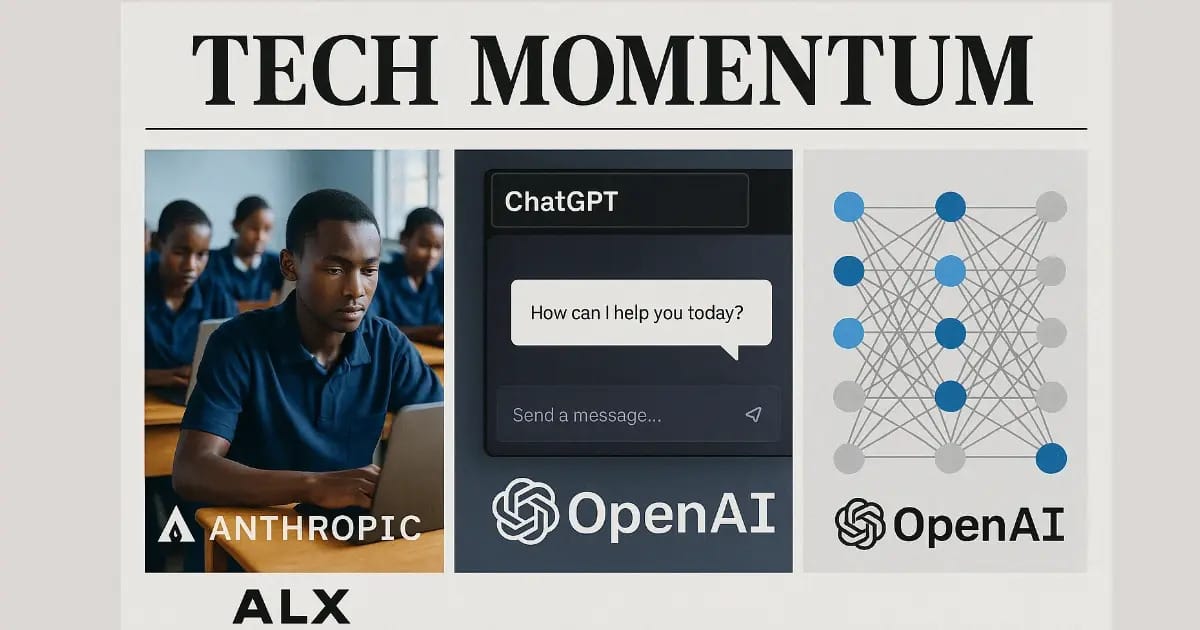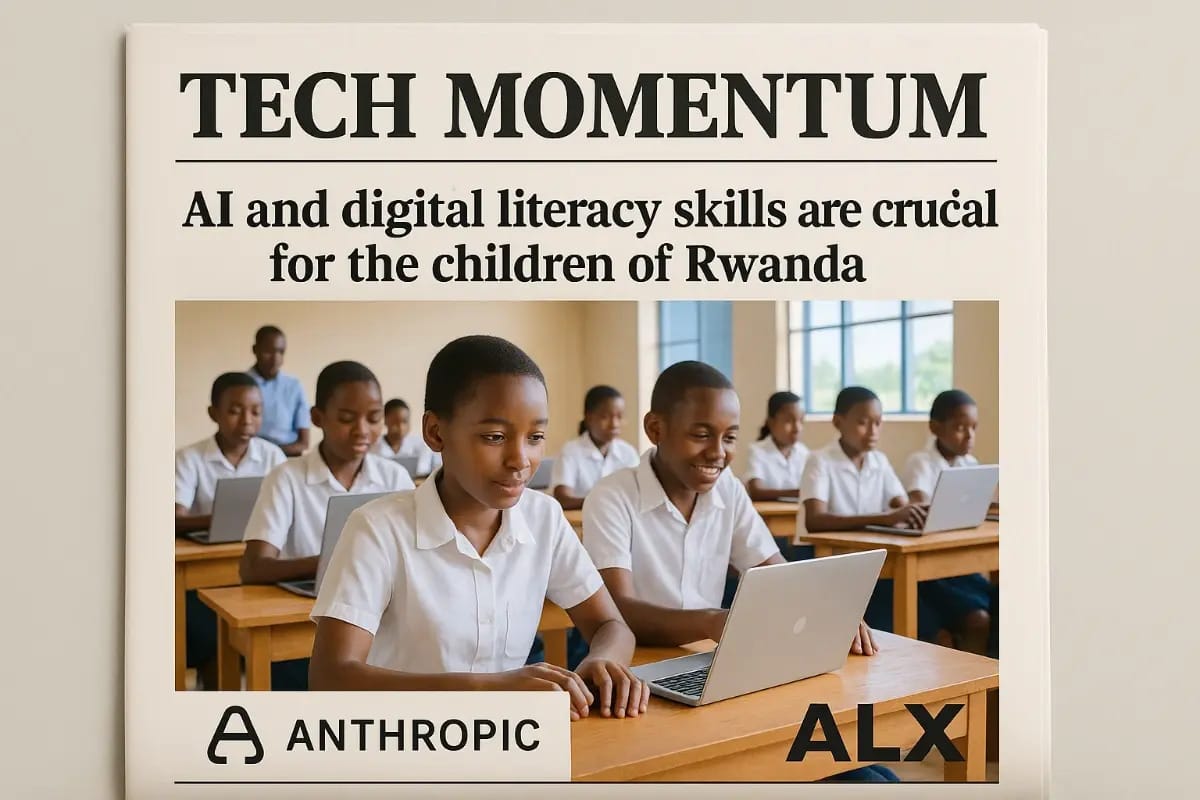- Tech Momentum
- Posts
- Big Shifts, Bigger Wins
Big Shifts, Bigger Wins
Get insights on ChatGPT’s writing update, Rwanda’s AI learning rollout, and OpenAI’s transparent sparse circuits in this sharp weekly briefing.

Welcome to Tech Momentum!
If you want an edge in AI, the biggest wins often hide in unexpected places. A punctuation fix, a national adoption program and a breakthrough in model transparency all signal a new direction. You get clearer tools, smarter systems and more control.
Let’s break it all down!
Updates and Insights for Today
You’ll Love This — ChatGPT Finally Stopped Spamming Em-Dashes
You’ll Gain AI-Skills: Rwanda Launches Claude-Powered Learning
You Get Clarity — OpenAI Builds Traceable Neural Logic
The latest in AI tech
AI tools to checkout
AI News
You’ll Love This — ChatGPT Finally Stopped Spamming Em-Dashes
Quick Summary
OpenAI CEO Sam Altman announced via X that ChatGPT will now respect custom instructions to avoid using em-dashes. The change is being called a “small-but-happy win” by Altman.
Key Insights
The em-dash has become a visible “tell” of AI-generated text, due to its frequent use by ChatGPT and similar models.
ChatGPT’s custom instructions now include punctuation directives—users can tell it not to use em-dashes, and it will comply.
The update highlights how much effort is still required to refine AI writing behaviour—even for something as basic as punctuation.
Why It’s Relevant
If you use AI tools for content, this matters: formatting and punctuation are important for readability and perceived authenticity. For writers, editors and SEO specialists (like you, Tom), the ability to steer stylistic traits means fewer “AI-tells” in your output and better alignment with your brand voice. Also, it signals that AI vendors are focused not just on “big leaps” (like AGI) but on refining small but meaningful user-experience details.
📌 Read More: Arstechnika
You’ll Gain AI-Skills: Rwanda Launches Claude-Powered Learning
Quick Summary
Anthropic is teaming up with the Rwanda government and ALX to deploy the AI learning companion “ Chidi ” across African education systems. The initiative aims to train thousands of teachers and reach hundreds of thousands of learners.
Key Insights
Rwanda will train up to 2,000 teachers and civil servants to integrate Claude-based tools into classrooms.
Learners will access Chidi via ALX programmes, helping them build skills like data analytics and cloud computing.
Since rollout, the tool logged over 1,100 learner conversations and nearly 4,000 sessions, with 9 in 10 users reporting positive experiences.
The partnership supports Rwanda’s “Vision 2050” to develop an AI-ready workforce and knowledge economy.
Why It’s Relevant
For you, this is a major case study in how AI meets education at scale — useful for writing about AI deployments, workforce readiness, and emerging markets. The initiative shows how public-private partnerships can push AI literacy in regions with fast-growing digital economies. Plus, it may influence how AI for education is marketed, adopted and localized globally — good material for SEO angles in your research and articles.
📌 Read More: Anthropic
You Get Clarity — OpenAI Builds Traceable Neural Logic

Quick Summary
OpenAI trained new “sparse” neural networks where most weights are forced to zero, producing clearer, smaller circuits that can be mechanistically interpreted. They show that increasing sparsity and model size improves interpretability without losing the learning ability.
Key Insights
Dense neural networks are hard to understand because each neuron connects to thousands of others.
By forcing most weights to zero (i.e., sparsifying the connections), OpenAI created models with “disentangled circuits” that perform defined tasks and are traceable.
On test algorithmic tasks, sparse models required up to ~16× fewer neurons/circuits to perform the same loss as dense models.
Though promising, the approach currently works on smaller models and simple tasks; scaling to frontier-models remains a challenge.
Why It’s Relevant
For you who write about AI, this is a critical shift: the focus is moving from bigger models to models we can understand. That matters for editorial credibility (you can explain how models work, not just what they do), for safety/regulation (transparent models are easier to audit) and for SEO content (interpretability is a growing trend). Also, if you cover AI tools or workflows, this gives a strong story angle: transparent AI = trust = adoption.
📌 Read More: OpenAI
The latest in AI tech

1. Google DeepMind: Hurricane Forecasting
DeepMind’s new weather-AI predicts hurricane intensity faster and more accurately than traditional systems. During Hurricane Melissa, it identified rapid intensification earlier, giving responders more time. The model needs less compute, delivers quicker forecasts and could reshape global disaster-preparedness. Concerns remain about limited interpretability.
📌 Read More: The Guardian
2. AI Hype vs. Reality: WSJ’s Six-Chart Breakdown
The Wall Street Journal highlights how AI expectations exceed today’s infrastructure. Massive investment, power shortages and supply-chain gaps slow real adoption. Companies face rising costs while monetization lags behind investment pace. These charts show a market resetting expectations and confronting practical limits after years of over-optimism.
📌 Read More: WSJ
3. The Expensive Stuff Behind AI
WSJ examines the rising cost of AI: chips, data centers, energy and cooling define the new bottlenecks. Companies burn billions to scale model training, and growth depends on supply chains that can’t keep up. The piece stresses that AI progress is no longer about algorithms but about industrial capacity.
📌 Read More: WSJ
4. Jeff Bezos Joins Project Prometheus
Jeff Bezos steps in as co-CEO of AI startup Project Prometheus, backed by $6.2B. It targets industrial AI, focusing on aerospace, manufacturing and hardware. With top hires from OpenAI, DeepMind and Meta, the company plans to merge advanced models with physical-world production. Bezos signals long-term commitment to deep-tech AI.
📌 Read More: The Verge
AI Tools to check out
1. LitVideo
LitVideo is an AI-powered video creation platform that lets you turn text, images or existing clips into full videos with minimal editing skill.
👉 Try It Here: LitMedia
2. RemoveText
RemoveText is a web tool for cleaning up images or videos by removing unwanted text, logos or watermarks automatically. You upload media and it does the rest.
👉 Try It Here: RemoveText
3. HumanText
HumanText is an AI-humanizer tool that rewrites AI-generated text so it reads more naturally, “human-written” in tone, helping with readability and bypassing AI detectors.
👉 Try It Here: Humantext
4. AIVideoMaker
AIVideoMaker is designed specifically for AI-generated UGC (User Generated Content) ads: you provide script/image/audio, pick a presenter/avatar, and it builds videos that mimic real creators. Great for marketing.
👉 Try It Here: AI Video Maker
Thanks for sticking with us to the end!
We'd love to hear your thoughts on today's email!
Your feedback helps us improve our content
⭐⭐⭐Superb
⭐⭐Not bad
⭐ Could've been better
Not subscribed yet? Sign up here and send it to a colleague or friend!
See you in our next edition!
Tom


